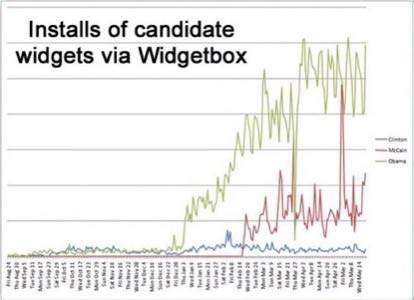Even though last night’s big contests in Kentucky and Oregon ended in a split decision, with big wins for both Senators Barack Obama and Hillary Clinton, most pundits now agree on who is most likely to be the Democratic nominee for president when the convention rolls around in August. Hint: it’s the candidate who has dominated nearly every method we could think of to measure election momentum on the web. We got some data last night from widget-provider Widgetbox that shows the same trend for viral widget installs.

We’ve long cautioned against putting too much stock into the web as a way to measure future results in an election — what worked for Obama did not work in the long run for Rep. Ron Paul. Clearly there is a lot more to winning an election than a strong online campaign.
That said, however, Obama has dominated the online discussion since day one. It would appear that when it comes to spreading his campaign message via widgets, there’s no exception to the rule — Obama widgets are far and away the most popular. (Though, note that the data on this graph is based on the candidate’s most popular widget in the Widgetbox system, and not averaged across multiple widgets — so it’s really only good for looking at a general trend.)

We tried to match peaks and valleys in widget installs to news events to see if there was any correlation, which is really difficult with this data. It looks like Obama saw a growing number of installs in the run up to the Ohio and Texas primaries (entering which he’d won something like 11 or 12 contests in a row) — then flat-lined for a month after he lost them. Clinton saw a modest bump after Super Tuesday in February where she scored huge wins in New York and California. Sen. John McCain saw a big dip the first week in March, which coincided with his becoming the presumptive nominee and President Bush’s endorsement (we’ll let you guess which might have turned people off his widget…).
But what’s important about this data, is the trends. Starting with the Iowa caucuses just after New Year’s, Barack Obama has seen his widgets spread steadily across the web. And even though his campaign does push the widgets on his site, 80-90% of new installs are coming via widgets embedded on non-official blogs — they’re coming from the grassroots rather than via the campaign itself. Clinton and McCain widgets are also being spread virally by supporters, though clearly not as fast. It does look like McCain supporters are doing a better job of embracing new web technologies than they were earlier in the election cycle, though — the first McCain widgets appeared on Widgetbox in mid-February and have enjoyed mostly steady upward growth since.
This is really just another data point to watch to gauge which candidate has momentum. It’s really quite amazing to look a things like YouTube, Twitter, Facebook, MySpace, and widgets to measure a US presidential election — the last time around most of these tools didn’t exist (or at least weren’t nearly as important).





















